Introduction. Leisure time as an area strictly separated from work did not exist in primitive societies. Rest or breaks in work existed in every society, but they were not the same as free time. The way of life in the original community referred exclusively to the existence and the collecting way of earning and maintaining existence. Work and rest in this society were not organized as a separate area of life, but were inextricably linked, both with other areas, as well as with family-tribal relations, but also with neighboring and friendly ties saturated with ritual-magical elements (Krivokapic, 2008). From the aspect of educational activity, free time in modern society is very recent as a social, cultural and civilizational phenomenon, which gives a new dimension to free time. Children's and young people's free time in extracurricular activities is considered particularly important. These activities can, due to their quality, become a relevant factor in their growth and development.
In order to understand free time as a separate category, we will first answer the question: What is free time? The spectrum of various definitions of free time is very wide and ranges from definitions that determine free time as a social ideal, all the way to definitions dominated by the opinion that it is the subjective feeling of an individual (Budimir-Ninkovic, 2008). If we look at free time as a social and civilization phenomenon, then it can be said that free time is a form of survival based on human self-realization (Bozovic, 1997). Viewed in this way, free time is determined as time that a person spends outside of regular, mandatory or any other work or task performing, i.e. time that is used for leisure, rest and recreation and which, to a good extent, traces the individual's own development and self-realization. Free time can be viewed through a sociological and pedagogical function. The sociological function refers to the useful use of free time in the sense of maintaining working condition in the context of a more cultural and satisfying way of life of working people, while the pedagogical function refers to the selection of activities for quality use of free time (Grandic and Letic, 2008).
The variety of definitions of free time, and also their conceptual divergence, shows that it can be viewed from three aspects, namely: a) the time that remains after fulfilling professional, family and other obligations; b) the time that an individual freely disposes of; c) the time for rest, recreation, cultural improvement, personality development in general (Mikanovic, 2015). Each of the aspects of free time mentioned above, as a new content of the entire pedagogical thinking and action, contains elements of personality development, which indicates the need to train a person for quality implementation of free time, which is achieved through education. Development in free time should lead to the development of a versatile and free personality, capable of a diverse, rich, cultured, healthy and satisfied life, humane ideas and contents. Therefore, the process of training a person for purposeful use of free time becomes a pedagogical task, and free time also becomes a pedagogical category. By reviewing the relevant literature, we can see that there are numerous understandings of the phenomenon of free time. Free time is a very complex research problem that can be viewed from a sociological, cultural, pedagogical, psychological, and ethical point of view, and multidisciplinary and interdisciplinary research in this area has special value.
The theoretical basis. Numerous studies show that the way of using free time has the potential to protect against stressful life situations (Coleman, Iso-Ahola, 1993; Trenberth, Dewe, 2002) and significant life changes (Kleiber, 1999). Thus, for example, active use of free time reduces the negative effects of unemployment and job dissatisfaction (Winefield et al., 1992). Also, volunteering in free time serves as a protective factor against stress at work (Mojza et al., 2010). Considering the aforementioned findings of previous research, it seems important to investigate ways of using free time, as well as their causes and effects. This topic is of particular importance in the range of ways in which young people spend their free time. Namely, on one hand, the way in which young people spend their free time can play an important role both in the acquisition of new knowledge and in the development of social skills and relationships, because it is free time that shapes the social context for the development of personal competencies and resources (Iso-Ahola, Crowley, 1991). On the other hand, the quantity of unorganized and low-quality spent free time has shown to be an important predictor for the use of narcotics and the emergence of antisocial forms of behavior (Iso-Ahola, Crowley, 1991; Mahoney, Stattin, 2000; Bartko, Eccles, 2003).
When it comes to physical activities, significant research is oriented to examining the activities of young people, more precisely, their willingness to engage in various sports activities in their free time. A study conducted on secondary school age respondents showed that grammar school students were still interested in sports activities in the first years of their schooling, that with the transition to the higher grammar school cycle of education, the preference for sports activities decreases, and the interest in ICT increases. The author of the study points to the problem of moving away from a healthy lifestyle, and the discrepancy between the physical and mental development of students at this very important stage of development (Cucui, 2018). Unfortunately, although patterns of physical activity are created at an early age (Buckworth, 2001), many studies conducted at the end of the 20th and the beginning of the 21st century indicated a tendency for a continuous progressive decline in the rate of physical activity of students during adolescence (Ucar et al., 2000; Somoglu, Yazici, 2021; Russell, Sampson-Moore, 2022; Sankofa et al., 2023).
The inactive way of life of students, whether at the initial or final stage of university education, has been the subject of research in many studies, both in the country and abroad. Demographic factors, knowledge, attitudes and beliefs are often cited as key factorsfor the formation of passive and active attitudes towards physical activity (Dishman, 1994). The most common external barriers cited are lack of time, lack of social support, time constraints due to school obligations, preoccupation with social and family activities (Allison et al., 1999; Grubbs, Carter, 2002; Gyurcsik et al., 2004), and as internal barriers, negative attitude towards physical activities, failure to recognize their importance, practicality, expediency and usefulness, ambivalent attitude towards activities, feeling of laziness or apathy, opinion of incompetence for this type of activity (Gómez-López et al., 2010), lack of motivation, fatigue (Allison, 1999), lack of self-confidence were cited (Allison et al., 2005).
A Belgian study showed that students attributed the choice of an inactive, sedentary lifestyle to factors such as: hedonism, obsession with social networks, lack of parental control and social support, bad role models, physical environment (availability and accessibility of sports activities, travel time), macro environment (the media). It is interesting that the academic environment (lifestyle at the university, exams, academic pressure) was perceived as a factor of inactive behavior of students, but also as a significant resource for animating students to physical activity (Rowe et al., 2021).
Turkish students also primarily cite external barriers as the reason for insufficient physical activity: lack of free time due to a complex schedule of academic activities, family obligations, social interaction; also the fact that academic success is more important to parents than exercise, etc. (Arzu et al., 2006). These findings are in accordance with the findings of other studies that also place the lack of free time at the top of the list of reasons for students not to engage in physical activity (Grubbs, Carter, 2002; Gyurcsik et al., 2004).
In a research aimed at examining the relationship between socio-demographic factors, motivation and practicing of physical activities of Spanish students, a relationship between physical activity habits and practice of a healthy lifestyle was observed. Physically inactive male students spent more time in front of the computer, and female students in front of the TV. They also consumed cigarettes and alcohol more often. It is interesting that the educational status of mothers and their habits of physical activities influenced the decision to actively engage in physical activities, both in boys and girls (Romaguera et al., 2011). The same was confirmed in a study conducted on the female population in Saudi Arabia. It was shown that there was a prevalence of physical inactivity among female students, that a higher level of physical activity was exercised by female students whose mothers were highly educated, who were married and lived far from the parks (Khalaf et al., 2013).
The age of students was also linked to their physical activity. It was established that physical activity improved the quality of life of the elderly (Joseph et al., 2014), and that sports activity was associated with life satisfaction of students (Koçand Inan, 2021; Somoglu, Cihan, 2021) and with personal happiness (Öktemand Çingöz, 2023).Other independent variables, such as the proximity of exercise facilities and provision of exercise equipment in home conditions, also proved to be statistically significant in terms of the intensity, frequency and duration of students' physical activities. Physical activity of students also often correlates with academic success of students (Miletic, 2017; Maldari et al, 2023). The choice of faculty often affects the frequency and character of students' physical activity, as well as the understanding of its importance for a healthy life (Peltzer et al., 2015).
When it comes to students, future class and pre-school teachers, the findings are similar to the findings of the abovementioned studies and show that these students practice physical activities, but not to a sufficient extent. For example, female students of teachers` faculty and faculty of medicine tend to have a more sedentary lifestyle compared to female students of the faculty of kinesiology (Mrakovic et al., 2014), which they justify most often by the lack of time, poor organization, insufficient motivation and lack of desire to engage in physical activity. The more frequent choice of students, future pre-school teachers, are social networks in comparison to social interaction through sports and recreation (Pantic, Stamatovic, 2018).
Methodology and methods. The research is based on a random and stratified sample of students in the first and fourth year of studies at the pedagogical faculties in Užice and Vranje (N = 210) (Table 1). Given the large, disproportionate numerical difference in the total number of male and female students, there was no research segment on the potential influence of the "gender" variable on the final results of the research, for the difference of other research variables (year of birth, year of study, program, doing sports).

Starting from the goal of the research Examine to what extent and in what way students of pedagogical faculties practice physical activities in their free time, the following scientific research tasks were determined: a) to investigate the positioning of physical and sports activities in students' free time in the spectrum of other activities; b) to determine the frequency and nature of physical activities in students' free time; c) to examine how students perceive predictors and distractors of their own physical activity in free time; and d) to establish whether independent variables (year of study, study program, age, doing sports) affect the final results of the research.
The investigation of the transverse nature was carried out using an appropriately constructed questionnaire.
The obtained data were analyzed using the IBM SPSS (version 24.0) software package, calculating the Chi square (c²), contingency coefficient, arithmetic mean, standard deviation, frequency and percentage expression of the results. Statistical significance was tested at the p = .01 level and p = .05. Based on the relative ranking of leisure activities, a ranking position was determined for each individual activity. The degree and order was expressed by descriptive analysis, which established what kind of importance students attached to certain activities at the manifest level. Based on the obtained results, ranking lists of selected free time activities were made.
Research Results and Discussion. Positioning of activities in students' free time(Positioning of activities in students' free time). Starting from the first scientific research task, the preferences of students' free activities were analyzed. Namely, the students had the task of ranking, according to the degree of frequency of exercise, the following leisure activities: watching television, listening to music, trips and walks, social networks, hanging out with friends, reading books, housework, attending sports competitions, sports activities (individual and collective), visiting cultural events (theatre, cinema, concerts, galleries...), humanitarian activities, dance activities (folklore, dance schools...), recreation (rollers, mountain climbing, yoga, pilates...), computer games, hobby activities, games of chance (bookmakers, lotto...), sleeping and lounging.
The research has shown that the students of pedagogical faculties prefer relaxing leisure activities. They put hanging out with friends on the first ranking place, listening to music on the second, trips and walks on the third and social networks on the fourth. At the bottom of the list are dance activities (15th position), computer games (16th position) and games of chance (17th position). Recreation and sports activities occupy the central part of the ranking list (10th and 11th rank), while interest in sports events occupies the fourteenth position. The obtained results of this part of the research represent a general insight into the positioning of physical and sports activities in the spectrum of other activities of students in their free time. The findings should be taken with a grain of salt, as they often represent a more embellished reality. It is evident that the physical and sports activities of students unfairly occupy an unsatisfactory ranking position, which raises the question to what extent and in what way students practice physical activities in their free time. Therefore, the next research task is oriented towards finding answers to the indicated questions.
Frequency and nature of physical activities in students' free time (Frequency and nature of physical activities in students' free time). When it comes to the frequency of physical activities in the free time of students of pedagogical faculties, the obtained parameters show that an approximately equal percentage of students engage in some physical activity several times a week (35.70%), or several times a month (32.40%). A devastating finding is that one third of the surveyed students (33.00%) do not engage in any physical activity at all (Table 2).
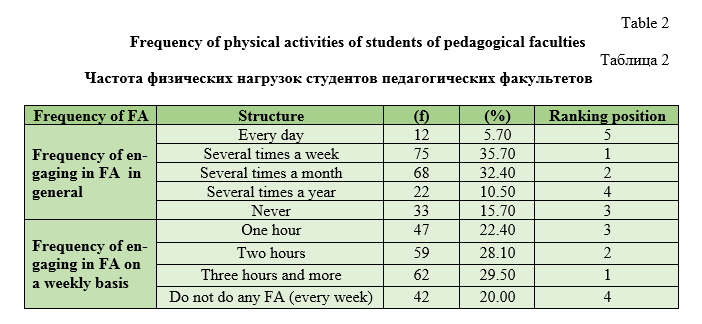
We were particularly interested in how much time students spent on physical activities on a weekly basis. The obtained results show a relative uniformity in the dispersion of responses, which we assume is the result of active or recreational exercise of physical activities. Namely, an almost approximate percentage of the respondents opt for the offered categories of time duration of the activity (Table 2).
The part of the research related to the examination of the nature of physical activities involved a multiple choice from the offered list (running, walking, football, volleyball, basketball, cycling, roller skating, dancing, folklore), with the possibility of additional entry (something else). Students had the task of answering the question: What physical activities do you most often engage in? It has been shown that students mostly engage in hiking (walking - 73.33%), followed by cycling (39.52%), running (34.76%) and roller skating (20.47%). Even 82.38% of the surveyed students did not mention any additional physical activity (something else). The obtained results are in partial agreement with the findings on the possession of props for sports and sports activities. A bicycle is owned by 74.76% of the students, a ball by 51.42% and roller skates by 32.38%. However, it is interesting that somewhat under four fifths of students own a bicycle, and only two fifths of students actively use a bicycle in their free time. The general impression is that students have equipment for sports and sports activities (in addition to the above mentioned: weights, skis, rackets, skates...), but that they do not use them sufficiently. It is necessary to find answers to these questions as well.
Predictors and distractors of students' physical activity in their free time (Предикторы и дистракторы двигательной активности студентов в свободное время). The need for additional external support and motivation for more frequent physical activities is expressed by half of the surveyed students. 29.5 % of the students are undecided on this issue, while 20.50% of students do not require additional support. We were interested in whether students who did not require additional support were considered sufficiently empowered to engage in physical activities.

The findings show that 11.00% of them are considered sufficiently empowered (in this group are also the students who declared themselves as athletes), while 4.80% of the surveyed students declared that they did not expect additional support for engaging in physical activities. Partly encouraging is the fact that as many as 84.30% are undecided on this issue, which opens up space for increased affirmative action by all relevant factors of the social environment.
The most common type of support students expect from their peers (46.20%), family (16.70%), sports clubs (5.20%) and educational institutions (4.80%). They gave the least trust to the youth association, the media and the local community (Table 3).
The fact that educational institutions have occupied an unenviable position in this context encouraged us to investigate the attitude of students toward the potential predictive role of the faculty in empowering students to engage more actively in physical activities in their free time. In this sense, the students' expectations are high: 71.90% of the surveyed students believe that the faculties should take a greater part in the offer and organization of physical and sports activities, 8.10% of the respondents expressed a negative attitude on this issue, while 20.10% is the percent of undecided students.
Students mention lack of time (49.50%) and poor offer (24.80%) as the most common distractors of their own involvement in free activities. It is interesting that the amount of the membership fee is not an obstacle to the decision to engage in physical activities (Table 3).
The influence of independent variables on the final results of the research (Влияние независимых переменных на конечные результаты исследования). The independent variables: age, year of birth, year of study, programs of study did not affect the final outcome of the research. No statistical difference was found at any significance level (p .01 and p.05). However, when it comes to the influence of the variable “doing sports”, the statistical parameters show (c² = 71.186; df = 34; p = .000) that students who are actively involved in sports, position sports activities (individual and collective) from the list of activities in their free time in the first three ranking positions, in contrast to those who do sports recreationally (rank 10 and 11) and students who do not engage in sports (rank 14 and 15). Also, students who are actively involved in sports put attending sports competitions at the top of the list of their own free activities; the same cannot be said for students who are doing sports for recreational purposes and those who do not do any sport, positioning this activity at the bottom of the list (c² = 43.026; df = 10; p = .0001).
Social networks especially attract the attention of students who are not engaged in any sport, but also of those who do some sports recreationally. In support of this, statistical significance was determined regarding the positioning of this activity (c² = 59.415; df = 34; p = .004). Unlike those who place social networks high on the list of leisure activities (first three ranking positions), student athletes place this activity at the back of the list (13th position).
Analysis of research results (Анализ результатов исследования). Starting from the problem, goal and task of the research, and based on quantitative and qualitative analysis, we conclude that the majority of free time students of pedagogical faculties use for fun, i.e. relaxing free activities (hanging out with friends, listening to music, trips and walks, social networks), which is most often a qualification of a sedentary lifestyle. It is evident that these are needs with impoverished contents oriented towards the development of physical abilities. The same findings were reached by Mrakovic, Matovic and Nedic (Mrakovic et al., 2014). It is particularly alarming that social networks are at the top of the ranking list of the most frequently practiced leisure activities, which can be assessed as one of the key factors in moving away from physical activities and a healthy life.
Active participation of students of pedagogical faculties in physical activities is minor: a little over one third doe’s physical activities several times a week, most often walking and cycling. An alarming fact is that less than a quarter of the surveyed students devote only one hour a week to these activities. The obtained results of the research are largely in agreement with research that indicates a tendency of a permanent progressive decrease in the intensity of physical activity of students (Trost et al., 2002; Ucar et al., 2000; Cucui, 2018), especially in the adolescent period.
It is indisputable that, due to pre-exam and exam obligations, students have little free time which can be fulfilled with physical activities. However, as shown by similar findings (Coleman, Iso-Ahola, 1993; Trenberth, Dewe, 2002), such situations can be overcome by a good and quality offer. By this we mean activities through which students will develop their physical abilities, which will create a frame of reference for the further creation of universal values of future generations. Given that patterns of physical activity are created at an early age (Buckworth, 2001), the value-conative behavior patterns of future teachers and pre-school teachers are of particular importance, either as a model, or as a resource and potential for the action.
Taken as a whole, noticing and understanding of both external and internal barriers key to the active exercise of physical activities by students is equally important for finding essential solutions related to the improvement of physical activities of young people (Gyurcsik et al., 2004; Allison et al., 2005). The encouraging fact is that half of the surveyed students expect additional external support and motivation to engage in physical activities more often, most often from peers, family, and sports clubs. As the most common distractors of physical activities, students single out: lack of time, inadequate offer (Allison et al., 1999; Grubbs, Carter, 2002; Gyurcsik et al., 2004), but also a negative and ambivalent attitude towards physical activities (Gómez-López et al., 2010). Therefore, the results of our research are in complete agreement with the findings of foreign studies, as well as the studies that note that female teachers' students justify their sedentary lifestyle by lack of time, insufficient motivation and lack of desire to engage in physical activities (Mrakovic et al., 2014).
It is interesting that three fifths of students expect a greater participation of the faculty in the offer and organization of physical activities, which actualizes and strengthens the predictor role of the faculty regarding the contribution of quality organized free time of students (Rowe et al., 2021). In this context, it is necessary to create, develop and improve models of encouraging students' physical activity. There is an emphasis on encouraging students' aerobic activity, where faculties and universities offer an adequate environment and physical education courses or activities (fitness, walking, running and swimming) that promote aerobic fitness (Anton et al., 2011; Loflin, 2014). Only such an approach can determine future teachers and pre-school teachers to promote a healthy lifestyle and implement physical activities at an early age (Mrakovic et al., 2014).
Conclusions. The results of the transverse nature research conducted on a sample of 210 students of the pedagogical faculties of Užice and Vranje (Serbia) show that students prefer a sedentary way of organizing their free time. More often they opt for less physically demanding activities such as hanging out with friends, listening to music, socializing with peers and friends, social networks. From the point of view of the nature of physical activity, students most often choose less demanding physical activities, such as walking and hiking, which once again confirms their commitment to a qualitatively more passive way of spending their free time. They receive the greatest support and encouragement for greater involvement in physical activities from their peers and family, while lack of time and a poor offer are the main reasons for their indecision on this matter.
Seen as a whole, students of different ages, years of study and study programs (pre-school teacher and class teacher) prefer leisure activities in the same way, while students who are actively involved in sports rank physical activities and activities of a sporting nature highly.
In the end, when we see the overall findings, in the context of the obtained research results that indicate the connection between physical activities and quality of life (Joseph et al., 2014), the connection between sports activities and life satisfaction (Koç, Inan, 2021) and personal happiness (Öktemand Çingöz, 2023), the question can be raised: whether a physically inactive class teacher and pre-school teacher can promote a positivist attitude towards reality and whether he can positively influence young generations. Accordingly, further research should be focused on the experimental examination of the effects of different models aimed at empowering students for a more active and better design and organization of free time, thus improving the quality of life.













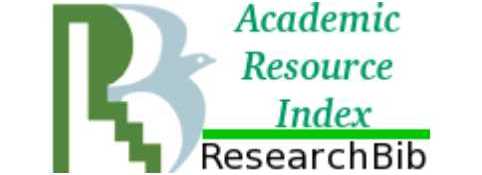

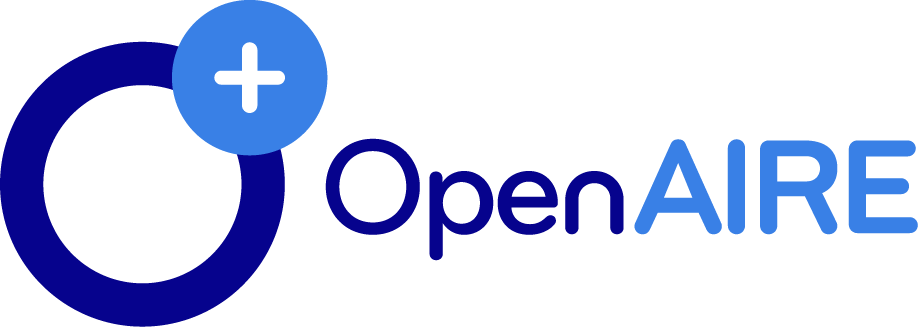
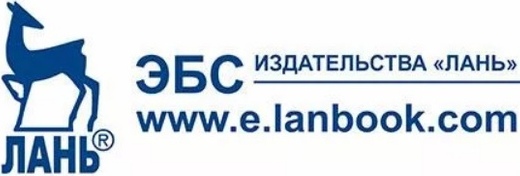
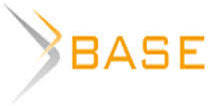


Reference lists